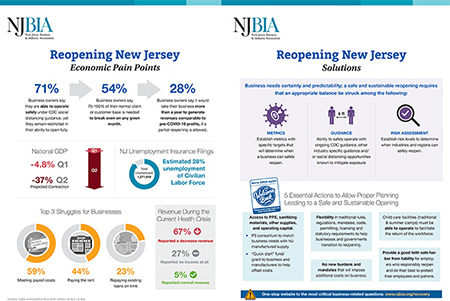The New Jersey Business & Industry Association today released a new Reopening New Jersey infographic, identifying the state’s pain points and urging swift solutions to bring much-needed certainty and predictability now to New Jersey businesses.
The infographic, found here, follows a business coalition letter sent to Gov. Phil Murphy last week detailing and expressing the immediate need of the administration to take industry best practices and create prescriptive guidance for businesses to reopen.
“If these solutions found in the Reopening New Jersey infographic are followed, it will give businesses and nonprofits the predictability and certainty they desperately need now to reopen,” NJBIA President and CEO Michele Siekerka said.
- Metrics with specific targets that will determine when a business can safely reopen
- Prescriptive guidance from the state to safely operate with ongoing CDC guidelines
- Specific risk levels (industry, size, capacity, geography) versus one-size-fits-all solutions
“This guidance is critical to businesses because every penny they have at this point is precious,” Siekerka said. “When they go to retool or retrofit their place of business for safety’s sake, they need to know they’re doing it properly and not wastefully. Over 70% of businesses surveyed by NJBIA said they can open safely, but they need specifics to ensure sound investment that will pass regulatory compliance requirements that are expected.
“When it comes to risk assessment, there should be different levels based on industry types, the size of a business and the location of a facility, especially as it relates to hot spots,” Siekerka added. “Not everyone should be held to the highest risk level, nor should every business need to wait for the most vulnerable region to hit a threshold target. As such, a one-size-fits-all approach in not appropriate.”
- Access to PPE, sanitizing materials and other supplies and operating capital
- The operation of child care facilities to facilitate a return to the workforce for many parents
- Flexibility in requirements for rules, regulations and mandates to help business and governments transition to reopening
- No new burdens or mandates on business
- A good faith safe harbor from liability for employers who reopen in accordance with proper guidance and do their best to protect employees and patrons

